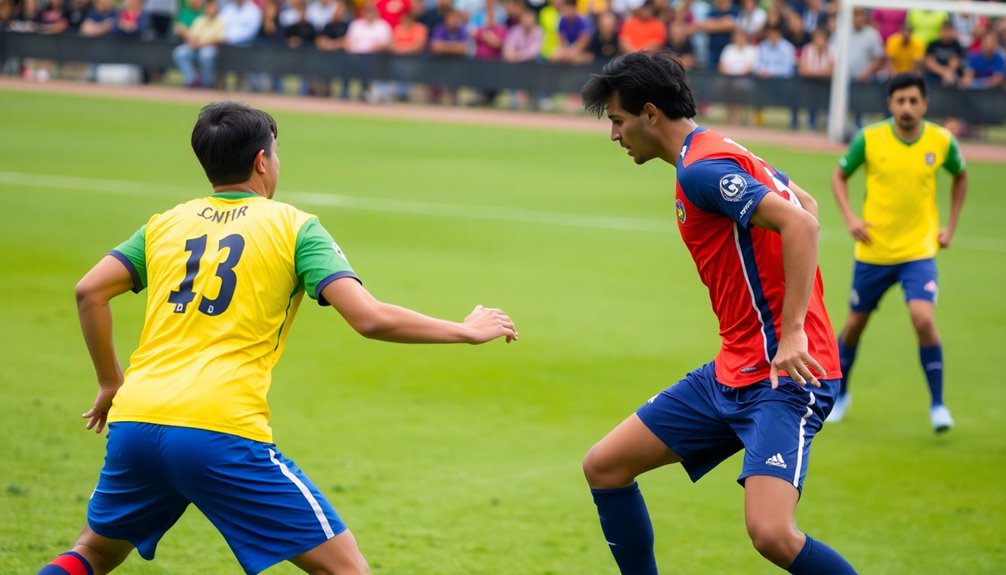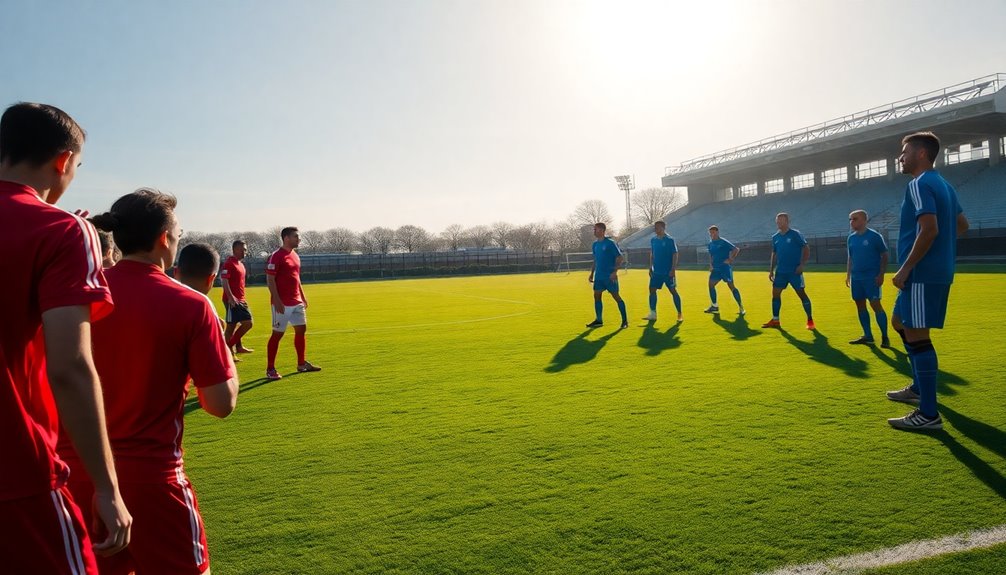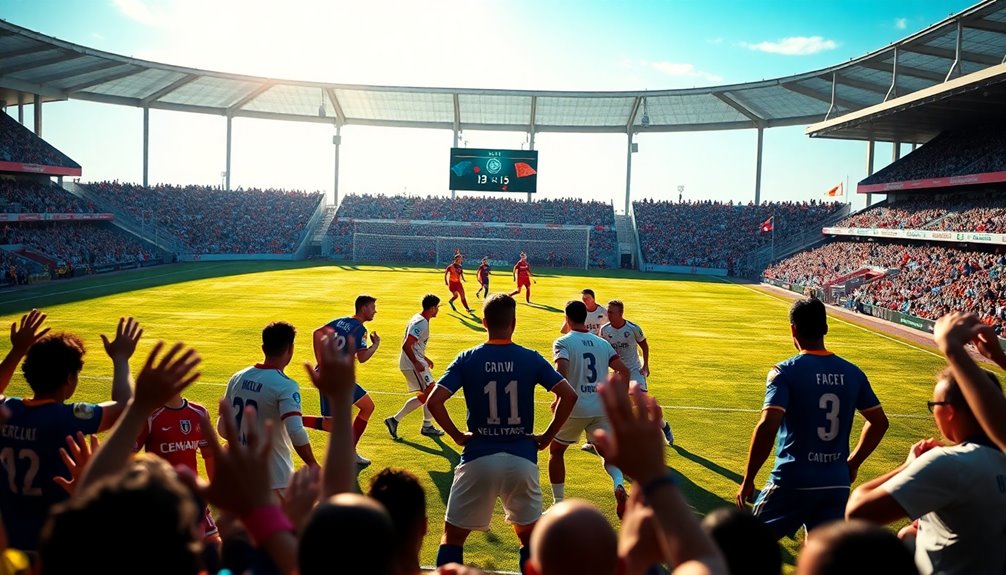
Strategies for Achieving a Soccer Draw and When It’s Ideal
February 24, 2025To achieve a soccer draw, focus on solid defensive formations like 4-4-2 or "Park the Bus." Effective communication among your team is essential for maintaining shape and minimizing gaps. Mark opponents tightly and apply a high press to disrupt their rhythm. It's ideal to settle for a draw against stronger teams or when you're away from home. Balancing defense with quick counter-attacks can catch opponents off guard. Stick around to discover more tactics for securing that essential draw.
Understanding the Importance of a Draw
While many fans focus on wins and losses, understanding the importance of a draw can be vital for a team's strategy. In defensive soccer, securing a draw can be a valuable tactic, especially when competing for playoff spots or trying to avoid relegation. By earning that significant point, you help maintain your team's standing in the league. Additionally, maintaining compactness in your defense can help secure those crucial draws against tough opponents. Consistent practice of defensive drills can also enhance a team's ability to hold onto a draw when needed.
In knockout tournaments, you might even choose to play for a draw against a stronger opponent, aiming to push the game into extra time or penalties. Additionally, a draw against rivals can disrupt their momentum while boosting your squad's morale and defensive reputation. Ultimately, accumulating draws can lead to higher final standings, proving that sometimes, a draw is just as important as a win. Effective communication enhances team spirit and coordination, which can be crucial in securing those vital draws.
Classic Defensive Formations
When you're looking to secure a draw, classic defensive formations can be your best friend.
The 4-4-2 formation balances solid defense with quick counter-attacks, while the "Park the Bus" strategy focuses on creating a compact block to thwart any scoring chances. Understanding how to implement these formations effectively can make a significant difference in your game plan. Furthermore, utilizing compact defensive shape helps prevent exploitable gaps and enhances overall defensive solidity. Incorporating effective marking and pressing strategies can further strengthen your defensive approach, making it harder for opponents to find space and create scoring opportunities. Additionally, a well-structured formation such as the 5-3-2 formation provides an additional layer of defensive security, making it even more difficult for opponents to penetrate your defense.
4-4-2 Formation Benefits
Classic defensive formations like the 4-4-2 and 5-4-1 offer significant advantages for teams aiming to secure a draw.
The 4-4-2 formation creates a solid defensive unit with two banks of four, allowing you to absorb pressure while being ready to counterattack. Central midfielders play an essential role, covering large distances to guarantee stability and support both defense and attack. Meanwhile, the wide midfielders enhance coverage on the flanks, enabling quick changes and crosses during counterattacks.
On the other hand, the 5-4-1 formation strengthens your defensive unit by adding an extra center-back, making it tougher for opponents to penetrate. Both setups limit scoring opportunities for the opposition, leading to a lower expected goals (xG) ratio.
Park the Bus Strategy
Implementing the "Park the Bus" strategy can be a game-changer for teams looking to secure a draw against stronger opponents. This classic defensive formation, often set up as 4-5-1, prioritizes goal prevention, frustrating opponents and limiting their scoring chances.
As pressure mounts, you might shift to a 6-4 formation to reinforce your compact defensive shape, making it even harder for the opposing team to find space. Success hinges on disciplined defensive organization and clear communication among players to maintain a clean sheet.
Teams like Chelsea in the 2012 UEFA Champions League showcased how effective this strategy can be, enabling underdogs to neutralize stronger foes and achieve valuable draws or narrow victories.
The Role of Communication in Defense

Effective communication is crucial in defense, as it enables defenders to organize their movements and respond swiftly to the opposing team's tactics. By effectively communicating, you can guarantee your defensive line maintains its shape and quickly adjusts to threats. Defensive strategies play a significant role in enhancing your team's ability to manage various attacking scenarios.
Central defenders often take on the role of key communicators, using their vantage point to relay information and coordinate marking assignments. This teamwork allows you to anticipate actions, leading to more effective pressing and intercepting of passes. Incorporating passing accuracy drills during practice can significantly bolster your ability to make precise defensive plays.
Verbal cues are essential for limiting passing lanes and guaranteeing everyone understands their responsibilities. Regular drills, like shadow play and small-sided games, reinforce these communication skills, improving overall coordination even in high-pressure situations. Moreover, a strong defensive stance enhances your ability to react quickly and maintain balance during defensive efforts.
Compactness as a Defensive Strategy
To defend effectively, you need to maintain a solid defensive shape that limits your opponent's options. Anticipating their movements is key, as it allows you to position yourself strategically to intercept passes and block shots. Plus, strong communication among defenders guarantees everyone stays coordinated, making it harder for the opposing team to find gaps to exploit. Incorporating defensive drills into your training can enhance quick reactions and tactical decision-making, further solidifying your team's defensive structure. Additionally, understanding the importance of halftime adjustments can help you refine your defensive strategy during the match. A well-organized defense also minimizes the risk of being caught in offside positions, ensuring that your team remains compact and difficult to break down.
Importance of Defensive Shape
While a strong offense can win matches, maintaining a compact defensive shape is essential for preventing opponents from finding space to exploit. A well-organized defensive shape limits the area available for attackers, making it difficult for them to create goal-scoring opportunities.
Teams that prioritize this compactness, like those using the "Park the Bus" tactic, often focus on defensive solidity, increasing their chances of securing a draw. Close coordination among defenders enhances communication, allowing you to neutralize opposing threats effectively.
Furthermore, a compact defensive unit aids in counter-attacking strategies, enabling quick shifts to offense once possession is regained. Ultimately, understanding defensive shape leads to fewer goals conceded, increasing your chances of achieving favorable match outcomes.
Anticipating Opponent Movements
Anticipating opponent movements is essential for maintaining a solid defensive structure, as it allows you to position yourself strategically on the field.
By anticipating opponent movements, you can limit the available space they have, which makes it harder for them to create scoring opportunities. This compactness in your defensive unit not only disrupts their attacking flow but also enhances your ability to press effectively.
When you're in the right position, you can intercept passes and block shots more efficiently. Remember, when you're aware of where the opposition is headed, you can react quickly and adjust accordingly.
Staying compact and reading the game helps your team maintain organization and keeps the pressure on your opponents.
Communication Among Defenders
Effective communication among defenders is essential for maintaining a compact defensive formation, as it guarantees everyone knows their responsibilities and positioning during critical moments.
Central defenders often take the lead, using their field view to organize the defensive line. This cohesion limits space for opponents, making it tougher for them to find goal-scoring opportunities.
During matches, clear communication helps you execute marking and pressing strategies effectively, allowing you to disrupt the opposing team's attacks.
To enhance your team's compactness, incorporate regular drills that focus on defensive coordination and communication skills.
Effective Marking Techniques

Effective Marking Techniques
Marking is an essential aspect of soccer that can make or break your team's defensive strategy. You'll want to master effective marking techniques, like man-to-man marking, where you closely track a specific opponent, minimizing their goal-scoring opportunities. Alternatively, consider zone marking, which allows you to cover designated areas, helping maintain possession by managing threats collectively, especially during set pieces. Communication with your teammates is vital; keep each other informed about opponents' movements to avoid mix-ups. Additionally, hone your anticipation skills to read the game and predict runs, enabling you to intercept passes or block shots effectively. Understanding the importance of goalkeeper box rules can enhance your team's defensive strategies and increase your chances of maintaining a draw. Effective marking not only prevents goals but also helps to organize the defense, creating a more cohesive team effort in critical moments. A well-coordinated defense, particularly among defending midfielders, can significantly disrupt the opponent's offensive flow and increase your team's chances of securing a draw.
Pressing Strategies to Frustrate Opponents
To frustrate your opponents and regain possession quickly, implementing pressing strategies is crucial.
The high press strategy involves all ten outfield players applying pressure, forcing mistakes that lead to turnovers and scoring opportunities. This tactic is particularly effective against possession-focused teams.
To succeed, you need a cohesive unit; players must be mobile, unselfish, and ready to maintain high intensity. It's mentally and physically demanding, so rigorous training is essential to guarantee your team can sustain this pressure throughout the match.
Notable examples include Jürgen Klopp's teams, known for their relentless energy and effective ball recovery in advanced positions.
Counter-Attacking Opportunities

When the opposing team pushes players forward, you can seize counter-attacking opportunities to exploit the spaces they leave behind.
By sitting deep in your half, you can patiently wait for the perfect moment to regain possession and launch a swift attack.
Successful counter-attacks often involve a rapid forward pass, using long balls to bypass the midfield and target your fast attackers.
This strategy can frustrate possession-heavy teams, as they struggle to recover from your quick changes.
To maximize these counter-attacking opportunities, focus on maintaining a compact defensive shape, enabling quick ball recovery and immediate offensive action.
As shown by teams like Leicester City and Real Madrid, speed and technical ability in your forwards can make all the difference.
Analyzing Opponent Strengths and Weaknesses
To effectively analyze your opponent, start by identifying the key traits of their top players and how they impact both offense and defense.
Next, evaluate the tactical formations they favor to uncover potential vulnerabilities.
This knowledge can give you a significant edge in planning your strategy for the match.
Identifying Key Player Traits
While analyzing an opponent's strengths and weaknesses, it's crucial to focus on key player traits that can greatly influence the match outcome. Start by examining attributes like speed, technical skill, and tactical awareness to pinpoint threats.
You should also assess weaknesses, such as gaps in their defense or slow shifts, which can be exploited. Utilize player performance data, including pass completion rates and tackle success percentages, to gain insights into their capabilities.
Don't forget to study recent match footage; this reveals patterns in their play style and how they respond under pressure.
Finally, evaluate key player traits like communication skills and physical fitness, as these greatly affect the effectiveness of their overall strategy on the field.
Evaluating Tactical Formations
Understanding your opponent's strengths and weaknesses is essential for evaluating tactical formations effectively. By analyzing their playstyle, you can select formations that exploit vulnerabilities while minimizing your team's exposure to threats.
For instance, if you're facing a strong attacking team, a 4-5-1 formation can provide a solid defensive structure to help maintain a draw. If your opponent struggles with possession, implementing a high press can disrupt their rhythm and create counter-attacking opportunities.
Conversely, against physically dominant teams, using a long-ball tactic can bypass midfield battles and exploit gaps in their defense.
Finally, remain flexible and adjust your formations dynamically during the match based on real-time observations to increase your chances of achieving a draw under pressure.
Timing the Decision to Play for a Draw

Timing the decision to play for a draw can greatly impact your team's chances of advancing in a match. In knockout competitions, securing a spot in the next round often takes precedence over winning, especially against stronger opponents.
If you're down to ten players, it's essential to maintain a defensive structure to avoid further losses. Shift your tactics in the final 15-20 minutes if the score is level or if you're leading by a goal.
In league play, aiming for a draw can help secure significant points, particularly when facing relegation or playoff threats.
Always assess your players' fatigue levels before deciding; a tired squad may struggle to win the ball effectively or convert into a solid defensive stance.
Utilizing Substitute Players for Tactical Adjustments
When you're looking to secure a draw, utilizing substitute players is essential for tactical adjustments.
Fresh legs can shift the momentum, allowing you to press harder or shore up your defense as needed.
Tactical Shift Implementation
While the match unfolds, utilizing substitute players can be a game-changer for your team's tactical approach.
Tactical substitutions allow you to adjust formations, like shifting from a 4-4-2 to a 4-5-1, to either secure a draw when ahead or reinforce defense against strong opposition.
Substitutes can bring specific skill sets, enhancing your pressing strategy or solidifying your defense in high-pressure moments.
By exploiting mismatches or countering opposing tactics, you can strengthen your lines and control the midfield.
It's vital to implement substitutes with a clear understanding of their roles, like defensive midfielders to shield the backline or wingers to stretch the play, ensuring you maintain that competitive edge as the game progresses.
Fresh Legs Advantage
Incorporating fresh legs into your lineup can dramatically shift the game's dynamics, especially as fatigue sets in during the final minutes. The fresh legs advantage allows you to adapt and optimize your strategy effectively.
Here are some key points to ponder:
- Exploit Tired Defenses: Fresh substitutes can capitalize on defensive lapses from exhausted opponents.
- Increase Tactical Flexibility: Coaches can adjust formations mid-game based on how the match unfolds.
- Utilize Specific Skills: Substitutions can introduce players with unique strengths, like speed or technical finesse.
- Data-Driven Decisions: Analyze performance metrics to determine the best times for substitutions.
In high-pressure situations, you need to be strong with your choices. Fresh legs can be the game-changer you need to secure that crucial draw.
Training Drills for Defensive Cohesion

Effective training drills for defensive cohesion are vital for any soccer team aiming to secure a draw in tight matches. Incorporate shadow play drills to help defenders practice positioning and communication, simulating real-game scenarios without opposition. This enhances their ability to anticipate opponents' movements.
Small-sided games also foster quick reactions and decision-making, improving cohesion among defenders. Positional awareness exercises maintain shape and coverage, ensuring players understand their roles within the defensive structure.
Additionally, integrate video analysis sessions to highlight defensive errors and successes, refining positioning. Regular routines focusing on tackling, marking, and pressing strategies are essential for building a solid defensive unit that can effectively defend and maintain a draw when necessary.
The Psychological Aspect of Playing for a Draw
Often, teams that play for a draw find themselves grappling with a defensive mindset that can stifle their attacking creativity. This psychological pressure affects players' confidence and decision-making, causing them to hesitate in vital moments.
Here are some key aspects to take into account:
- Caution vs. Creativity: Players may become overly cautious, fearing the repercussions of conceding a goal.
- Stress Levels: Balancing defensive duties with exploiting counter-attacks can heighten stress.
- Coaching Influence: Coaches often motivate teams by emphasizing the significance of a draw in tournament settings.
- Mixed Perceptions: Players and fans might view a draw differently, impacting team morale.
Ultimately, while it's strategic, this mindset can limit your attacking players' ability to shine on the pitch.
Historical Examples of Successful Draws

Draws in soccer can serve as pivotal moments in a team's journey, turning potential defeats into triumphant advancements. Historical examples of successful draws illustrate this perfectly.
In the 1994 FIFA World Cup final, Italy and Brazil drew 0-0, with Italy later winning the championship through penalties, showcasing defensive strategy.
Fast forward to the 2005 UEFA Champions League final, where Liverpool's resilience shone as they recovered from a 3-0 deficit to draw 3-3 against AC Milan.
At the 2012 London Olympics, Mexico's 1-1 draw with Brazil led to gold after penalties.
Finally, in the 2018 World Cup, Denmark's 1-1 draw with Croatia resulted in an advance through shootouts.
These examples highlight how draws can propel teams forward in critical tournaments.
Balancing Defense and Attack
While pursuing a draw, it's crucial to strike a balance between solid defense and opportunistic attack.
Here are some key strategies to help you defend effectively while remaining ready to capitalize on offensive opportunities:
- Adopt a strong formation: Use a 4-5-1 setup to maintain a compact defensive shape.
- Control possession: Aim for 60-70% possession with tactics like tiki-taka to limit opponent chances.
- Utilize defensive midfielders: They shield your defense, regain possession, and aid in shifting to attack.
- Implement a high press: Disrupt your opponent's flow and create openings for quick counter-attacks.
Engaging Supporters During Tense Matches

Tense matches can create an electric atmosphere, and engaging supporters during these moments can greatly elevate your team's performance. When fans are actively involved, studies show their presence can boost a player's performance by up to 10%.
Utilize social media for real-time updates and behind-the-scenes content to keep supporters engaged and foster community. In the stadium, create a lively atmosphere with chants and coordinated cheers that directly motivate players.
Encourage fans to join pre-match activities, like interactive games and meet-and-greets, to deepen their emotional investment. Implementing a fan feedback system during matches allows supporters to share their thoughts, making them feel valued.
This engagement not only enhances loyalty but also strengthens their connection to the club.
Conclusion
To summarize, playing for a draw can be a smart strategy, especially when facing stronger opponents. You might think it's a boring approach, but it's about securing essential points and showcasing resilience. By implementing solid defensive tactics and maintaining clear communication, your team can effectively manage the game. Remember, a draw can be just as satisfying as a win when it preserves your position in the league. Embrace the strategy, and enjoy the thrill of the game!


